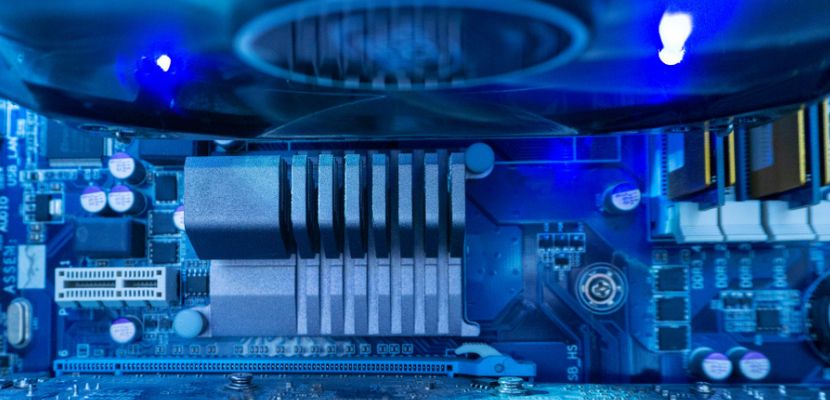Liquid immersion cooling is an advanced thermal management technique where electronic components are fully submerged in a dielectric fluid to efficiently dissipate heat. This method is increasingly used in high-performance computing and data centers to enhance cooling efficiency, reduce energy consumption, and support higher-density hardware configurations.

What Is Liquid Immersion Cooling?
Liquid immersion cooling is a thermal management technology in which electronic components, such as servers or other hardware, are entirely submerged in a dielectric fluid, typically non-conductive and engineered to efficiently absorb and transfer heat away from the components. The process involves the fluid's direct contact with the hardware, allowing for superior heat dissipation compared to traditional air-cooling methods. This technique is particularly valuable in environments requiring high-performance computing, where heat generation is significant and maintaining optimal operating temperatures is crucial.
By submerging the components, liquid immersion cooling enables a more uniform temperature distribution, reduces the risk of overheating, and enhances energy efficiency by minimizing the reliance on mechanical cooling systems like fans and air conditioners. Additionally, it supports higher hardware density and can lead to lower operational costs due to reduced energy consumption and extended equipment lifespan.
This technology is gaining traction in data centers, supercomputing facilities, and other industries where managing heat is a critical concern.
How Does Liquid Immersion Cooling Work?
Liquid immersion cooling works by directly submerging electronic components in a specialized dielectric fluid, which is non-conductive and designed to efficiently absorb and transfer heat. Here's how the process operates:
- Submersion of components. The hardware, such as servers or GPUs, is fully immersed in the dielectric fluid within a sealed tank or enclosure. This fluid does not conduct electricity, ensuring that the components can function normally without the risk of short circuits.
- Heat absorption. As the electronic components operate, they generate heat. The dielectric fluid, being in direct contact with these components, absorbs the heat rapidly and efficiently.
- Heat transfer. The heated fluid rises within the tank due to natural convection, where a heat exchanger can cool it. In some systems, the fluid is actively pumped through a cooling system that removes the heat before the fluid is recirculated.
- Cooling and recirculation. The heat exchanger or cooling system removes the absorbed heat, cooling the fluid back down. The cooled fluid is then recirculated within the system, continuously repeating the process to maintain optimal operating temperatures.
- Energy efficiency. Liquid immersion cooling significantly enhances energy efficiency by reducing or eliminating the need for air conditioning and mechanical cooling systems. The method also allows for higher component density in the same physical space, potentially saving costs in data centers and other high-performance environments.
Air Cooling vs. Immersion Cooling
Air cooling and immersion cooling are two distinct methods of managing heat in electronic systems, with significant differences in efficiency and application.
Air cooling relies on fans and heat sinks to dissipate heat from components into the surrounding air, which is then expelled from the system. While this method is widely used and straightforward, it becomes less effective as hardware density and performance demands increase, often requiring additional cooling infrastructure like air conditioners, which raises energy consumption and operational costs.
In contrast, immersion cooling submerges components in a dielectric fluid that directly absorbs and dissipates heat more efficiently. This method not only enhances cooling performance, particularly in high-density and high-performance environments, but also reduces energy usage by minimizing reliance on mechanical cooling systems. However, immersion cooling involves more complex setup and maintenance compared to traditional air cooling, making it more suitable for specific applications like data centers and supercomputing facilities where thermal management is critical.
Single-phase vs. Two-phase Immersion Cooling
In single-phase immersion cooling, the dielectric fluid remains in its liquid state as it absorbs heat from the components and is then circulated to a heat exchanger to be cooled before recirculating. This method is simpler and more straightforward but generally less efficient in heat transfer.
In contrast, two-phase immersion cooling involves the dielectric fluid boiling as it absorbs heat, changing from a liquid to a vapor. The vapor then rises, condenses on a heat exchanger, and releases the heat before returning to a liquid state. Two-phase cooling is more efficient in heat transfer due to the latent heat of vaporization but requires a complex system design to manage the phase change process effectively.
Liquid Immersion Cooling and Data Centers
Liquid immersion cooling is increasingly being adopted in data centers as a solution to the challenges of managing heat in high-density environments. Traditional air-cooling methods often struggle to keep up with the demands of modern, high-performance computing hardware, leading to inefficiencies and higher energy costs. Liquid immersion cooling provides more effective heat dissipation, allowing for greater hardware density without the risk of overheating. This approach not only improves energy efficiency by reducing the need for power-hungry air conditioning systems but also supports more sustainable operations by lowering overall cooling-related electricity consumption.
As data centers continue to grow in size and complexity, liquid immersion cooling is emerging as a key technology to enhance performance, reduce operational costs, and meet the increasing demands for greener, more efficient data center solutions.